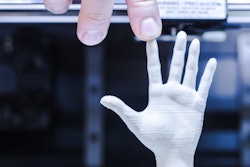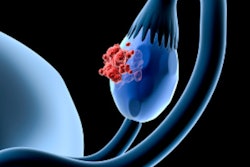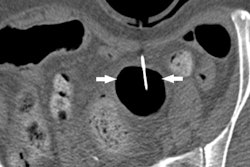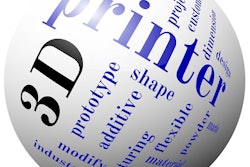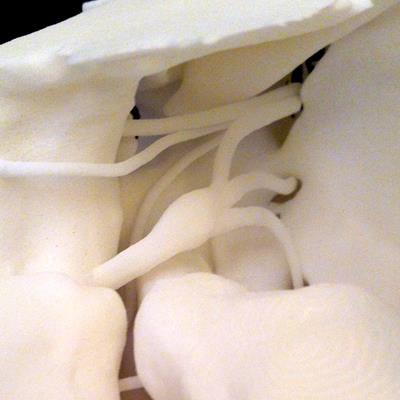
Researchers have created a high-resolution model of a 3D-printed brain and skull base from CT and MR images that details the cranial nerves in ways that outperform standard diagnostic images. The complex neuroanatomy of the nerves can be better understood and depicted by the use of highly customizable 3D-printed models, according to a report in the Journal of Digital Imaging.
In their project, researchers from George Washington University in Washington, DC, manually perfected the computerized segmentation of the cranial nerves and brain stem on MR images after initial 3D reconstruction. They created the bony skull base from CT data, using free software to create smooth, graphically designed cranial nerves and ensure proper fitting of each nerve into the neural foramina. A commercial service was used for printing.
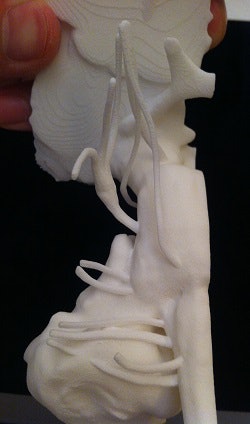 Image of 3D-printed cranial nerve model created from MR and CT images of the cerebellopontine angle and skull base. All images courtesy of Dr. Ramin Javan.
Image of 3D-printed cranial nerve model created from MR and CT images of the cerebellopontine angle and skull base. All images courtesy of Dr. Ramin Javan.The result was a durable and accurate 3D-printed model of the cranial nerves using actual patient MR and CT images of the cerebellopontine angle and skull base, according to Dr. Ramin Javan and colleagues (JDI, February 21, 2017). The resulting models can be used for teaching purposes for neuroradiology fellows and residents rotating through their section, Javan wrote in an email.
"What this adds to pure cross-sectional imaging is a significantly improved three-dimensional understanding of the anatomy, which at times is not well-visualized on imaging due to their small size, imaging technique, presence of artifacts, or distortion by pathologic processes such as tumors," Javan said.
Knowing the expected course of the nerves is important for subspecialty-level neuroimaging interpretation.
Existing models inadequate
There are few publications covering custom 3D printing of cranial nerve models, the authors wrote. The only commercially available physical models tend to be of the entire brain and contain only the root entry zone, lacking the entire course of cranial nerves fitting into the skull base and also customizability.
Better cranial nerve models are needed not only for surgical planning, but also for surgical simulation. A detailed model could be used to practice surgical procedures such as neurovascular decompression microsurgery for trigeminal neuralgia, or resection of vestibular schwannoma and cerebellopontine angle masses, the team wrote. This project sought to build a more functional and workable cranial nerve and brain stem model than was available previously.
The three components of the model included the cranial nerves; the brain stem, which served as the trunk of the cranial nerves; and the osseous skull base. Fitting the components together is an important design element, so that the pieces are easily put together and easily separable. The components should ideally be from the same patient; however, design software can adjust the pieces from multiple patients after reconstruction, if needed.
Building the model
The design work was performed on an Apple MacBook. Software included 3D Studio Max (Autodesk), Photoshop (Adobe), OsiriX Lite, a Mac-based PACS, and Mimics (Materialise) to create the stereolithography (STL) files, which could alternatively be created without proprietary software but with additional processing time.
The model began with a set of high-resolution MR images of the brain exported with window and level settings that enabled the cranial nerves to be well-visualized in the background of cerebrospinal fluid. JPEG images were the foundation for 3D reconstruction of a rough model of cranial nerves I-XII as they exit the brain stem.
The images were manually segmented using Photoshop, implementing the magic wand tool in high-magnification views -- a time-consuming project. The original grayscale images were used to manually segment the cranial nerves. The stacks of segmented JPEG images of the cranial nerves and brain stem were separately imported into OsirX Lite using JPEG-to-DICOM rendering.
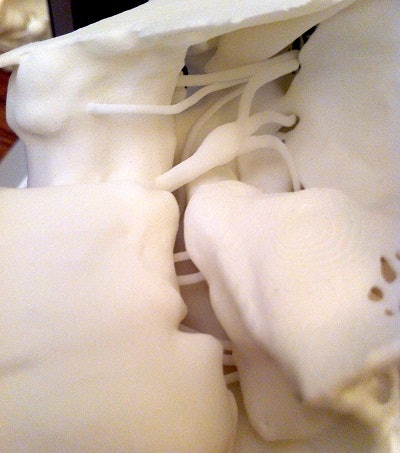 Additional views of 3D-printed cranial nerve model created from MRI and CT of the cerebellopontine angle and skull base.
Additional views of 3D-printed cranial nerve model created from MRI and CT of the cerebellopontine angle and skull base.Alternatively, Mimics delivers far faster manual segmentation of the cranial nerves in addition to a separate automatic segmentation of the skull base, the authors wrote. Mimics also handles 3D surface volume reconstruction, enabling the export of each mesh as an STL file. The software's nerve tracing function was very useful for this project because it allowed for the creation of a user-defined spline or curved path defined by sequential points in 3D space.
3D Studio Max was then used to enhance and modify the initial design of the 3D model by importing each STL file into the same design environment, the authors wrote.
The virtual cranial nerves must fit into the 3D reconstructed skull base, which contains spaces that allow passage of the nerves into their respective foramina and fissures, they wrote. The skull base was then halved to allow for better visualization. Materialise was used to perform the 3D printing offsite with a polyamide material, after increasing the scale to 120% for better visualization and to increase the thickness and strength of the free-hanging cranial nerves. Each model cost about $120.
The resulting models are durable and accurate, and they are mainly used as educational and testing tools for understanding the spatially complex anatomy of the cranial nerves and skull base, "providing an opportunity for handheld spatial reasoning for medical students as well as radiology and neurosurgical trainees," the authors wrote. The strong, slightly flexible material can withstand small impacts and resist pressure while being bent, they added.
Owing to significant stairstep artifacts in the native 3D reconstructed cranial nerves, the nerves were replaced by virtual 3D tubular structures that followed the path of the reconstructed cranial nerves, digitally attached to the brain stem.
The selective laser sintering technique used to produce the model enables the greatest freedom of design among 3D printing techniques. The material comes in only one color but can be painted. Also, it can break, especially the more delicate components such as the cranial nerves. Another limitation is that graphic design skills are required to modify the 3D meshes in 3D Studio Max.
"Probably the biggest challenge in graphically designing 3D models is meeting all requirements for an STL file, which essentially means that it can truly exist in the real physical world accounting for all vertices, edges, and faces," they wrote. Models cannot contain unwanted faces or edges.
Streamlining the model creation process would be the next step if the model were to be used in the clinical setting, they wrote. Accurately co-registered CT or MR angiography or susceptibility-weighted images would be one such path.
"There certainly are ways to improve upon the current 3D model," Javan wrote in his email. "Part of the focus of this paper was to introduce a ... method for developing detailed 3D-printed models ... using freeware. This was achieved using Photoshop for slice-by-slice segmentation, OsiriX for 3D reconstruction, and 3D Studio Max for 3D graphic design and modification."
Commercial software speeds the first two steps to create visually appealing cranial nerves, but the final 3D graphic design/modification step is still needed, he said. Nerve tracing tools are now available to consolidate the above steps, where users can manually create 3D representations of nerves in a 3D-printed model.
In other potential improvements, the arterial system could also be added to emphasize anatomic relations that are important when discussing the neurovasculature of the skull base, Javan noted. Vasculature is important for understanding anatomy and in describing pathologic conditions such as trigeminal neuralgia or cerebellopontine angle tumor resections. Combining MRI with MR angiography or CT angiography data using manual or possibly automated or semiautomated digital subtraction or addition techniques could depict it.
"The ultimate goal is beyond teaching of normal anatomy," Javan said. "It is to bring this concept into the clinical realm, especially for accurate and detailed presurgical planning and surgical simulation."




